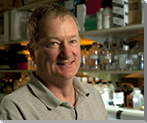David M. Bodine, Ph.D.

B.A. Colby College, Waterville, ME, 1976
Ph.D. The Jackson Laboratory/University of Maine, 1984
49 Convent Dr, MSC 4442
Bethesda, MD 20892-4442
Dr. Bodine's research focuses on hematopoiesis, the regenerative process in which a small pool of undifferentiated hematopoietic stem cells (HSC) proliferate and differentiate into all of the different types of cells found in the peripheral blood. As the progeny of HSC multiply, they become restricted to specific hematopoietic lineages, eventually becoming committed to maturing into one single type of cell that then circulates in the blood. Perturbations of this process cause a variety of disorders ranging from hematologic malignancy to anemia.
One of Dr. Bodine's research objectives is to understand the changes in epigenetic factors affecting hematopoiesis. To this end, his group is involved in work designed to extend The ENCyclopedia Of DNA Elements (ENCODE) Project into the study of primary cells. ENCODE was developed to identify all functional elements in the human genome, including epigenetic factors and transcription factor binding sites, and has primarily analyzed cell lines or cells in culture. The hematopoietic system provides a unique opportunity because, unlike cell lines, hematopoietic cells can be sorted into nearly homogeneous populations that are clearly defined by their in vivo and in vitro properties using flow cytometry. Researchers are thereby able to take "snapshots" of the state of the genome at different stages of hematopoiesis. In addition, although transcriptional profiles of many well-defined hematopoietic cells exist, changes at the DNA and chromatin level are likely to reflect changes in differentiating cells better and more accurately than changes in the steady-state level of mRNA.
Dr. Bodine's group is using new sequencing technologies that have made it possible to conduct genome-wide analysis of epigenetic marks on primary cells. They are particularly interested in discovering genes that have different epigenetic marks in HSC and common myeloid progenitors. Dr. Bodine's laboratory hopes to discover candidate genes and pathways that could be exploited to enhance HSC self-renewal, leading to safer and more effective bone marrow transplants.
Dr. Bodine and colleagues also study two genetic anemia syndromes. The first is caused by a deficiency of the transcription factor EKLF. By examining the genome-wide binding of EKLF in differentiating erythroid cells, they seek to identify EKLF-mediated steps in the differentiation process. These data will be merged with information about the binding of other erythroid transcription factors to identify "regulatory signatures" for different genes expressed in red blood cells. Dr. Bodine's group is studying the second of these syndromes in a mouse model for human Diamond Blackfan anemia, which is caused by expression of a mutant RPS19 gene. Mice expressing the mutant allele fail to complete erythropoiesis - the terminal differentiation of proliferating red cell progenitors into enucleated circulating red blood cells. With the hypothesis that the mutant RPS19 gene inhibits protein translation, Dr. Bodine's laboratory is conducting a proteomic analysis of mutant and wild-type cells to better understand the net effect of RPS19 mutations.
In chromosomes, individual loci and the chromatin surrounding them become active in specific cells while remaining silent in others. This activation may be associated with specific cis-acting sequences that are responsible for the establishment and maintenance of active chromatin. While certain DNA regulatory elements, such as promoters and enhancers, are well described in the literature, other critical cis-acting elements that prevent gene silencing (barriers) or the activation of neighboring genes (enhancer blockers) are not well defined. Dr. Bodine's group is conducting an in-depth analysis of barrier and enhancer blocking elements of two loci (ANK-1 and SLC4A1) that are expressed in red blood cells. His group has identified point mutations in a novel promoter element and in a barrier element at the ANK-1 locus that are associated with ANK-1 deficiency. They speculate that they will be able to use the same approach to identify barriers and enhancer blockers at the SLC4A1 locus. Knowledge of how these barrier and enhancer blocking elements function can ultimately be used to improve the safety and efficiency of vectors used in gene therapy approaches for treating specific diseases, such as sickle cell disease.
Last Updated: January 12, 2012



 (301) 402-0902
(301) 402-0902 (301) 402-4929
(301) 402-4929



